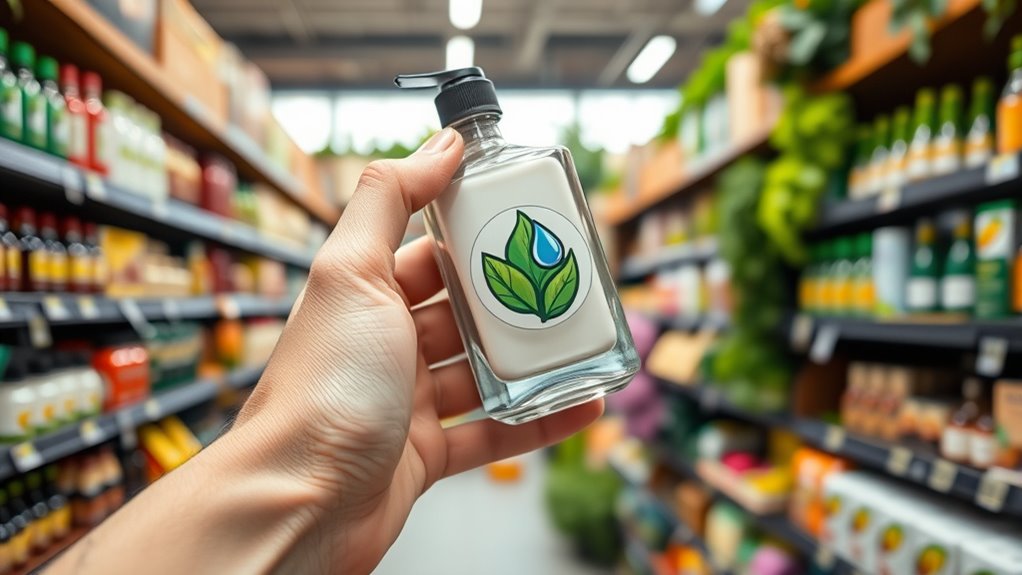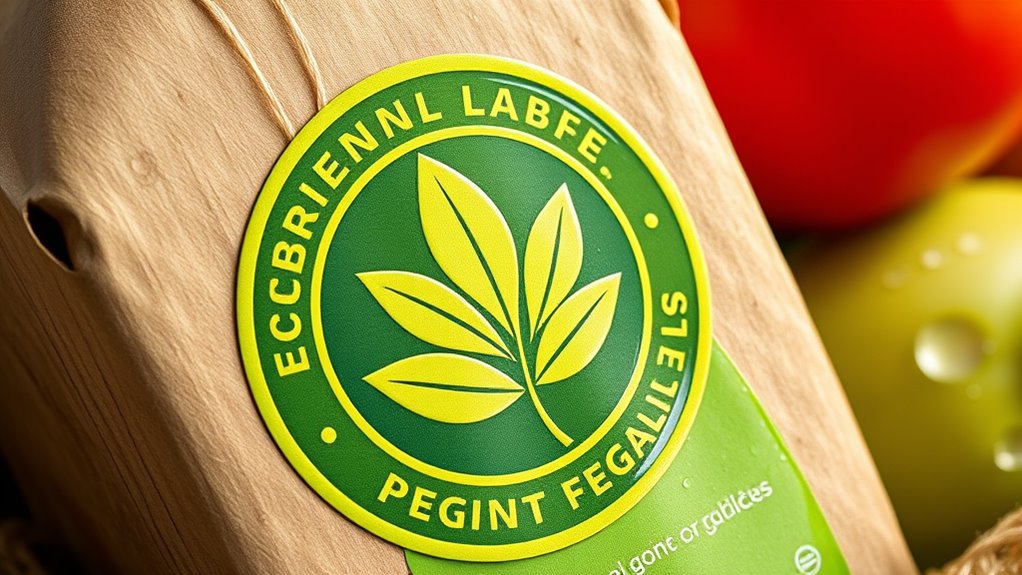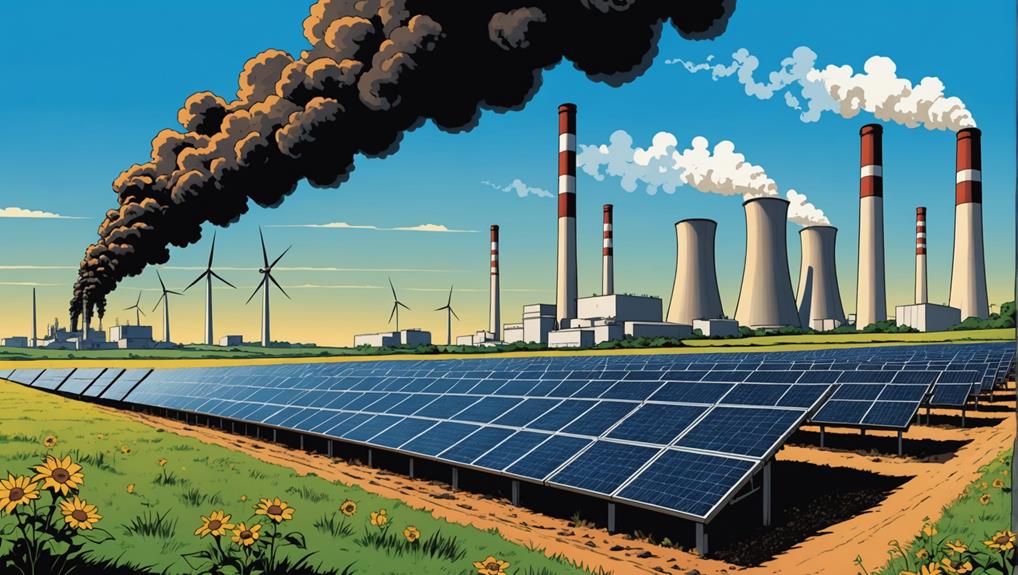Eco-labels help you identify products that meet genuine sustainability standards, covering areas like environmental impact, fair trade, and ethical practices. Look for labels backed by reputable organizations with regular audits and transparent certification processes. Combining multiple eco-labels can give you a fuller picture of a product’s sustainability. If you want to guarantee your choices truly support a healthier planet and fair labor, keep exploring how these labels work and what to look for.
Key Takeaways
- Look for eco-labels from reputable certifiers with transparent standards and independent verification.
- Understand the specific sustainability focus of each label, such as carbon footprint or fair trade practices.
- Use multiple eco-labels for a comprehensive view of a product’s environmental and social impacts.
- Check certification details and audit frequency to ensure the label’s credibility and rigor.
- Stay informed about technological tools like blockchain that enhance transparency and authenticity of eco-label claims.

Have you ever wondered how to identify truly eco-friendly products among countless options? It can feel overwhelming with so many labels and claims cluttering store shelves. That’s where eco-labels come into play—they’re designed to help you recognize products that meet specific sustainability standards. But not all eco-labels are created equal, so understanding what they signify is key to making informed choices. When you see an eco-label, check whether it addresses factors like a product’s carbon footprint or its adherence to fair trade principles. A label indicating a low carbon footprint means the product’s production and transportation have minimized greenhouse gas emissions, helping reduce your overall environmental impact. Fair trade labels, on the other hand, ensure that producers receive fair compensation and work under ethical conditions, often promoting sustainable farming and fair labor practices.
Eco-labels help identify genuinely sustainable products by highlighting low carbon footprints and fair trade practices.
As a conscious shopper, you want to support products that genuinely contribute to sustainability, but some labels can be misleading or lack transparency. To avoid falling for greenwashing, look for labels that are backed by reputable certifying organizations. These organizations often require rigorous standards and regular audits, so their labels are more trustworthy. For instance, a fair trade certification guarantees that the product was produced under fair labor conditions, with benefits like fair wages and community development. Similarly, eco-labels that focus on a product’s carbon footprint are based on lifecycle assessments, considering everything from raw material extraction to disposal, providing a clearer picture of a product’s environmental impact. Recognizing the role of independent certifiers can help ensure the credibility of these eco-labels. Additionally, technological advances like blockchain are being used to improve supply chain transparency and verification processes. Incorporating third-party verification further enhances the reliability of eco-label claims and helps consumers make more responsible choices.
Furthermore, AI security technologies are increasingly being used to monitor supply chains and verify compliance with sustainability standards, adding an extra layer of authenticity to eco-label claims. You should also be aware that some labels focus on specific aspects of sustainability, so it’s worth checking what standards they cover. Some may prioritize biodiversity, water conservation, or social equity, while others focus solely on organic or biodegradable materials. Combining multiple eco-labels can give you a more holistic understanding of a product’s sustainability profile. Additionally, look for transparency in labeling—reliable eco-labels often provide detailed information about their standards and certification processes, so you know exactly what you’re supporting. Moreover, understanding the relationship between different labels can help you make more comprehensive and responsible purchasing decisions.
In the end, choosing products with credible eco-labels means you’re actively supporting companies that prioritize environmental health and social fairness. It’s about making smarter decisions that align with your values, whether that’s reducing your carbon footprint or ensuring fair trade practices. By paying close attention to these labels, you empower yourself to select products that genuinely contribute to a more sustainable world.
Frequently Asked Questions
How Can Consumers Verify Eco-Label Authenticity?
To verify eco-label authenticity, you need to focus on third-party verification, which ensures independent assessment of sustainability claims. Stay informed about different eco-labels to boost your consumer awareness and recognize credible certifications. Always check for recognized standards and confirm the certifying organization’s credibility. By doing this, you make smarter choices, supporting genuinely sustainable products and encouraging companies to uphold environmental and social responsibility.
Are Eco-Labels Standardized Across Countries?
You might wonder if eco-labels are standardized across countries. While some international standards aim to harmonize certification processes, many eco-labels vary depending on local regulations and organizations. This means that a label in one country may not hold the same credibility elsewhere. Always check the certification process behind the label, and look for internationally recognized standards to guarantee you’re choosing genuinely sustainable products.
Do Eco-Labels Account for Social and Ethical Practices?
When you look at eco-labels, it’s important to know they often focus mainly on environmental factors, but some do account for social impact and ethical sourcing. You’ll find labels that verify fair labor practices and ethical sourcing, helping you choose products that support better social standards. However, not all eco-labels include these aspects, so you should always check the criteria to guarantee they align with your values on social impact and ethics.
How Often Are Eco-Label Criteria Updated?
You might wonder just how current eco-label criteria are, especially when it comes to essential issues like renewable energy and biodegradable packaging. These standards don’t stay static; they’re updated regularly, sometimes annually or even more frequently. This ensures products meet evolving sustainability goals, pushing brands toward greener practices. So, stay vigilant—your eco-conscious choices depend on the latest criteria, which adapt to new innovations and environmental priorities.
Can Eco-Labels Influence Product Pricing Significantly?
Eco-labels can substantially influence product pricing through the price premium they command. When you see a product with a trusted eco-label, your positive consumer perception often justifies paying more, as you believe it’s more sustainable. This increased willingness to pay a premium encourages brands to set higher prices for eco-labeled items, ultimately shaping the market dynamics based on consumer trust and perception of environmental responsibility.
Conclusion
By understanding eco-labels, you become a vigilant gardener tending a delicate forest, recognizing which trees truly support the ecosystem. Just as a compass guides explorers through uncharted terrain, these labels steer you toward products that reflect genuine sustainability. Remember, your choices ripple outward like stones cast in a pond, shaping a healthier planet. Stay informed, stay conscious—because every mindful decision plants seeds for a greener, more resilient future.










